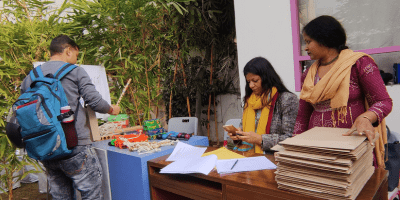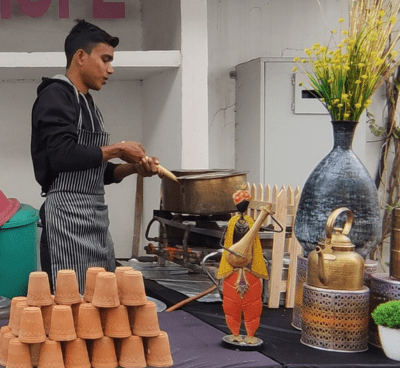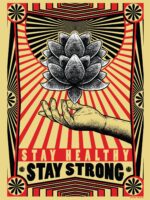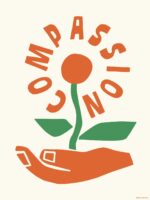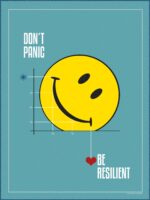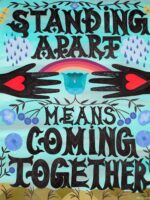Organizational Wellbeing: Transition and Changes + Wellbeing Organizational Wellbeing: Transition and Changes + Wellbeing
Guest post by:
Michelle Arevalo and Ramses Gomez
As I was preparing myself for hosting this interview, I found this quote by Heraclitus that says “There is nothing permanent except change” and when I read it a lot of questions started to come up: Why is it so scary, sometimes? Shouldn’t I be used to it? Why do some people refuse to change, then?
I have to admit that I spent some time trying to answer them (…without feeling any better, actually) before remembering the reason why I started to read about change; so I decided that instead of trying to solve my doubts alone, the interview with Michelle and Ramses was the perfect opportunity to share all these inquiries, both leaders and open people that have transitioned recently and maybe with their help I could find some answers for me and you.
The first question I asked them was which’s the most important thing they have learned from this moment of transition as a leader, it could be something on a personal and/or professional level.
Michelle: I have learned that the saboteur voices in our head are always the strongest when we’re going through a transition […] We all have this illusion of progress; that the next thing you do is better than the last thing you did, but it’s actually all cycles. […] So I see myself going into this transition as another cycle, not better, not worse than my last one, but it’s still a cycle and it’s a beginning and at the beginning, wherever you are, no matter if you’re, the CEO of the world […] or starting your own social project […] the saboteur voices take on a very different strength […] Learning that I’m putting my finger on it and saying: “Okay, voices, you’re a bit stronger today, It’s not me”, this “I’m listening to you more” has helped me a little bit more in maintaining peace and calm as I start a new cycle […] because it’s very easy to be hard on yourself when you’re starting something new.
Ramses: One of the most important insights that emerged from the process of transitioning for me was the realization that I work from, I don’t work for. […] The organization, regardless of the role that I play, must provide me with the opportunity to help build the society I want to live in, […] an equitable society, a fairer society, a more caring society for people and the planet. […] I’ll say that knowing that I work from and not for, liberates me in so many ways because taking the transition or the step to transition comes with personal judgment, potentially outside judgment or outside voices […] and just realizing that we are way more than just our roles and titles, it unlocks a beautiful potential for everyone.
After reading several times both answers while I was writing this document, I noticed that in their own way and with the help of each particular process, they increased their awareness about what actually motivated them to transition like the values, in Ramses case; and how they are living the process, noticing these unconscious thoughts or saboteur voices, like Michelle accurately called them, that sometimes avoid us of from taking big steps.
Listening to their learnings made me want to know if there was any recommendation or advice they would like to share with people facing a transition process and here is what they said:
Ramses: It’s important to call things for what they are. And transitions are transitions. In the bigger scheme of things, transitions are also evolution and when you put it like that, it makes things way less scary. […] It becomes more natural. Of course, it comes with challenges and pains and complications, but most of those complications are attached to a mindset that is something that we own and, most of the time, we have built […] If we realize it’s within us, then we can much easily (I wouldn’t say super easily) change it.
Michelle: One thing that you have to start with is just by being kind to yourself because you’re doing something brave. The two things that I would say, one is very practical. Think of your transition as something beautiful and something you need to sit on because we are so used to thinking, “Oh, what’s the next thing? What’s the next thing? I can’t be in a transition for too long”. […] If you sit with yourself and enjoy the transition, you will find out things about yourself that will allow you to take the next step willingly. If you go towards the next step to avoid your transition overall, then you might be escaping from something and you never want to feel like you start something as if you had escaped from something else. […] Nobody likes that feeling.
The second one is probably the hardest and the one that takes the most courage: Talk about things openly and a lot. A lot like: “if you think you’re done talking about it, talk about it again” because […] sometimes we don’t take chances because of the impact it has on others. […] In my case, I knew that it would impact my business partners, my team, my managing partner […] but once I talked about it […] The conversation that came from the heart was basically, “Wow, this is going to impact me, but I am with you.” […] If there’s something that you need to do, have the open, difficult conversations first, because in the long term, it would be better for sure.
Ramses: What I wanted to share is something that was very valuable for me and much connected to what Michelle was saying and the reason why I wanted to go back: “Being honest in moments of transition and it starts with you being honest with yourself, which is quite challenging” Then it has to do with […] colleagues and very close people and friends that will be affected or impacted by your decision. […] Something that I have constantly made sure that happens in my transitions […] is that for the last two weeks I made sure to book time with absolutely EVERYONE in the organization that I worked with […] I booked time aside, usually it’s outside the office […] and asked them three questions: The first one is, what’s your favorite memory of the two of us? […] then the second question is, what did you enjoy the most while working with me? And it might seem like it’s that you want to hear praise from others, but it’s just a mechanism to prepare them for the last question, which is […] what advice do you have for me before I start my new journey? […] I make sure that I have this conversation with a piece of paper and a pen so they write down the answers and then they read them to me […] I keep those papers in my night table and when I’m going through a difficult situation, it’s usually where I go for inspiration because that’s when people have been the most honest about who I am.
Sometimes when we face difficult or complicated situations, we can forget about taking care of our wellbeing, that is why I asked both members if transitioning affected them in that way, or maybe it didn’t.
Michelle: Caring for my own wellbeing is, in part, what prompted thinking that I needed to transition. […] Many people think of a transition like a breakup […] I think that I needed a different new challenge and that having my identity be so tied to my social enterprise was something that I needed to break up with. […] “I am not my project and my project is not me” and I wanted to prove myself; it was a big part of making sure that my wellbeing becomes whole. […] Going into a transition puts you in situations that are outside your comfort zone and I don’t think that’s bad for your wellbeing. […] Thinking that being outside your comfort zone is bad for your wellbeing is actually not the right way to think of this algorithm; it doesn’t work like that. […] You have to be a little bit outside your comfort zone so that your brain grows in many ways and gets you to places you never thought you could be. […] Transitions are hard, but they’re not necessarily hard because they’re bad for your wellbeing.
Ramses: In a way it provided me with […] so much clarity about what’s relevant for me and what’s needed in the new phase / organization / role / costs. What is it that I need to be existent in that new opportunity that will get me so excited to the point that will be relevant for me to look after it. […] And of course, that clarity usually is tied to complexity, you have to go through complexity to see the light. So, […] in that sense it was absolutely challenging and I wouldn’t say my wellbeing was affected […] There were many nights awake, many times where my emotions were so confusing and different and, in many cases, new and unexpected that… […] I was honestly going through a very vulnerable time, when things affected me or impacted me in ways I wasn’t expecting. But I think the beauty of the process is that, […] it provided me and forced me to bring clarity to my thinking by being in connection with what’s relevant for me.
The last two questions are more personal. Before doing this interview, I had a little context of Michelle’s transition process and I matched it with one of the ideas that came out from the Wellbeing Summit feedback session with the Ecosystem Network. Therefore I asked her: When did you know or how did you know when to step aside? How did you know that your personal project is ready to fly without your direct guidance?
Michelle: I think you have to start from an earlier question, which is: Not when, but why. Why would you want to step aside? […] in my case I had a very good clarity that someday I would step aside and that my project will transcend me […] I’ve seen a lot of people take sabbaticals and take breaks because it’s important to take a step aside, even momentarily. […] It’s not always the answer but, in my case, it was and I knew it for a couple of reasons: first I started thinking even more long term than the usual manager would. […] One day, really out of the blue, (maybe it was deep in my heart) I just answered: “My biggest dream is that IMPAQTO transcends me in whatever shape or form”. And that’s when I knew in my mind that I was thinking way longer term and my everyday actions after that started to change; I started to delegate more, I started to think less about the day to day indicators and I started seeing my team flourish[…] And there was a day when I just felt like, “Wow! this is right, this place can actually continue on without me”. Of course, there were also outside voices that were not very nice, a lot of people called me and said: if you step back, your business partners or investors are going to be angry, they invested in you […] I would just take that as feedback and that told me that I’m doing the right thing because that’s not what I was looking for.
I also knew I needed my identity to be more than just this specific project and, in my case, I already had the privilege of having gone through a previous transition before. I used to be a Human Rights lawyer; I worked with refugees in Asia, in Africa, in Latin America; I worked in Geneva, in Switzerland so I already have taken a big lead in a transition in a different way in my career; back then I also knew that the death of my dog prompted it, that grief prompted it.
And I knew it when I started listening to a voice deep down that was telling me to move on but also, I knew it because it was important to my wellbeing along with many things that I learned from The Wellbeing Project itself. […] in my case, TWP means that the social impact we’re doing with IMPAQTO now has a tremendous opportunity to continue growing and that it doesn’t depend on me, and that I can continue doing IMPAQTO in other places. It all comes from this awareness of me being a person separated from my project and all that awareness came from conversations with Xyme, with my colleagues and feeling that this is not something that I made up, you all put words to what I was feeling.
Finally, I also knew that Ramses had transitioned in the past, so my personal question to him was if he had faced any special challenge in his most recent process.
Ramses: This transition was the hardest and the easiest at the same time. It was the hardest because I had been at Sistema B for over 5 years and the organization was perfectly aligned with my values, with what I want to build for the world, the people, the colleagues, everything was a perfect match. So, in that sense leaving an organization that it’s so aligned is quite challenging. But when I say that this transition was the easiest, it’s because I could also see that the same values, vision and spirit was there, yet what was new and different, is the scale of the impact through the lense of a tech company.
I think that also what’s powerful with every transition is that it opens up the opportunity for new leadership to emerge and flourish. The more conscious the leaders happen to be about that aspect, the more they can catalyze it. So, I think all of us having meaningful, very honest and sometimes raw conversations with team members about how potential can be unlocked by an opportunity like this, but it has to be a co-construction; […] just to make sure it goes beyond the romanticism of the idea, but actually, one has to be very involved in the process of leading and making sure that there are the right conditions for everyone to take on it.
When the time of the interview was coming to its end, both members expressed some beautiful words about it:
Michelle: At least for me, such a welcome break… to have someone ask you deep questions and to think through the answers and to put your thoughts into words is very powerful. It’s a good format to think through different challenges. Thank you so much for asking thoughtful questions.
Ramses: It resonates with me a lot, thank you so much for the space, as Michelle and I always discuss how much we love the concept of “holding the space”. Thank you for holding the space for us because many wonderful things emerge when the space is curated well, when we realize that everyone has something valuable to say and even if the 2 of you are not speaking, the value comes from you having created the space. It wouldn’t happen if it wasn’t because of you. We all have to realize this is the contribution of everyone for beautiful things, valuable things have emerged and I’m just grateful for having the space where I can share things that are very personal but also that I feel very confident sharing outloud.
Michelle: This space that you are holding for us is also accessible for so many other people.
By the end of the interview I felt very inspired and motivated for changes; I thought about the future and the new beginnings I would face. But I think more important was that listening to them gave me the opportunity to reflect about my own processes and the way I am living them. I hope you have enjoyed this interview as much as we did.










